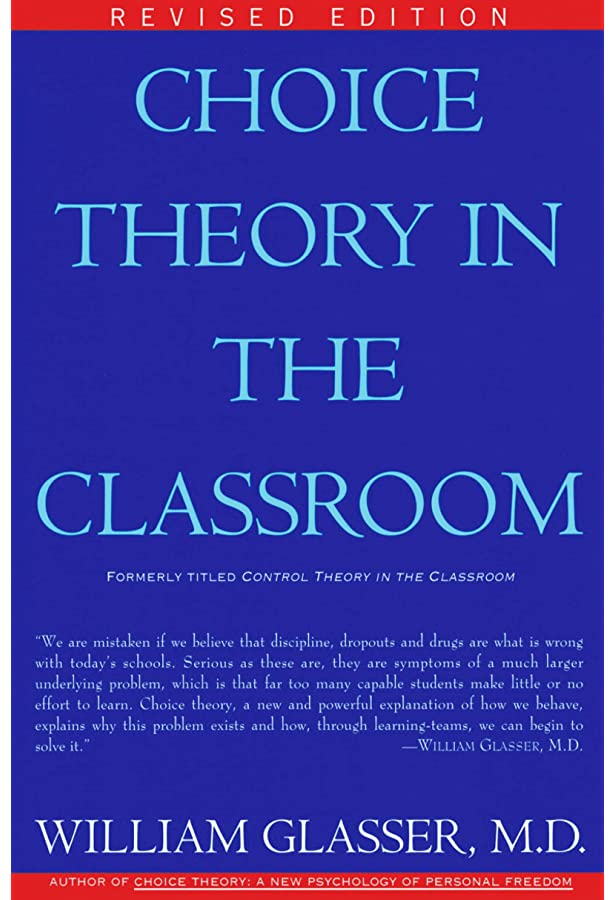Choice Theory in the Classroom Book Summary and Golden Lines
Use the learning team model to increase student motivation and sense of belonging.

As an Amazon Associate, I earn from qualifying purchases. All affiliate links are marked with an asterisk (*). Thank You! Read more here.

Choice Theory in the Classroom Book Summary and Golden Lines
Choice Theory in the Classroom by William Glasser M.D. was published in 1998. I first purchased this book when I was struggling to get a few students in my science classes to complete their work. let alone attempt it. Here I am years later, and I still have similar struggles with students, but implementing some of the ideas in this book has been helpful. Choice Theory in the Classroom is a worthwhile read.
The Book In Three Sentences
- Students (people) only learn when they see how it is beneficial to them.
- Cooperative learning is motivating for students, especially middle school students.
- Being a part of a learning team can foster a sense of belonging.
Golden Lines (description and free resource) - These are some of my favorite lines from the book along with my reaction.
Teaching is a hard job when students make an effort to learn. When they make no effort, it is an impossible one.
The ideas in this book make sense. I've noticed a larger percentage of my students struggle to put forth minimum effort. It is a helpless feeling to have as a teacher. When students are placed on learning it can provide another layer of motivation in that they are connected and accountable to their peers.
What choice theory teaches is that everything we do is initiated by a satisfying picture of that activity that we store in our heads as a pleasant memory. Therefore, a child who makes an effort to learn in school does so because he has a picture in his head that learning is satisfying.
The key is to find ways to show relevancy. What are the benefits in learning this material. Students are thinking to themselves, "Why should I try?". Cooperative learning can offer a better learning picture for students while they continue to formulate the importance of learning in the context of the life they want to lead.
There is no doubt in my mind that the picture of learning teams in their classes is satisfying to all their needs.
I think this over simplifies things. Learning teams can satisfy some of their needs, but not all. I think this is why schools staff are stretched so thin. The student needs are so great that its almost impossible in some cases to satisfy them to a point where learning is possible.
Any teacher who learns choice theory should share it with her students. My experience is that they pick it up quickly and begin to use it in their lives. As they begin to use it, they quickly learn that there are far better choices than sitting around complaining that they are the victims of situations they cannot control. They learn that they are rarely a victim, and if they choose to act like one, it is a foolish choice.
This is empowering for students to learn. The choice is theirs. In any given situation they have a list of options to choose from. This is true for adults as well. In the end, it's our reactions that define us.
In the choice theory learning-team school, where the teacher is less of a lecturer-leader and more of a facilitator-manager, there were be few major discipline problems. Satisfied students would stay in order because it would make no sense to disrupt.
I am happiest as a teacher when I am in the facilitator-manager mode. This allows me to work with small groups to provide on-demand instruction and feedback. The disruptions do occur, but since other teams are already actively learning, the rest of the class isn't held up by the student who is struggling to regulate their social and academic behavior.
Students gain a sense of belonging by working together in learning-teams of two to five students.
If students feel like they belong on a team, their effort improves. Creating an atmosphere where students are able to work in different teaming configurations is challenging, but when it happens it's a beautiful sight.
The teams are free to figure out how to convince the teacher and other students that they have learned the material. Teachers will encourage teams to offer evidence that the material has been learned.
More assessment structure is needed when learning teams are first introduces, but as they improve their collaborative learning skills they will become more effective at demonstrating what they've learned. This can be chaotic and fun. It also helps to have some systems in place to guide students in creating quality work.
Once the teacher begins to consider abandoning the worker role altogether, she will want to learn what she can do as a manager which goes far beyond the traditional concept of direct, reward, punish.
When I read this part of the book I thought about how teachers can create environments that are satisfying places to complete work in. Things like lighting and furniture configuration can help with this. I'm not a Pinterest classrom decor kind of teacher. Rooms like that look pretty cool, but many of them look like they might distract or over stimulate students. Starting with a variety of clutter free seating options will have a positive effect.

Choice Theory in the Classroom
Use the learning team model to increase student motivation and sense of belonging.
Thanks for reading. You can subscribe to receive updates by using the button below. You can find the rest of my book summaries here.



